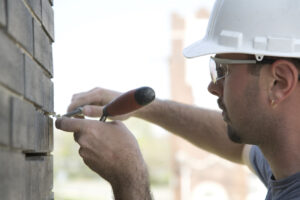 Repointing is required throughout the life of any masonry structure, although it’s not always the right answer. Repointing is the process of repairing the grout or joints between bricks when they become cracked or crumbly. By taking out the ruined mortar and replacing it with fresh mortar, you preserve the surrounding bricks from environmental and stress damages, which can otherwise lead to larger problems. Repointing offers an affordable way to restore masonry work, but it is not always the best option. Here we explain when you should avoid repointing and why.
Repointing is required throughout the life of any masonry structure, although it’s not always the right answer. Repointing is the process of repairing the grout or joints between bricks when they become cracked or crumbly. By taking out the ruined mortar and replacing it with fresh mortar, you preserve the surrounding bricks from environmental and stress damages, which can otherwise lead to larger problems. Repointing offers an affordable way to restore masonry work, but it is not always the best option. Here we explain when you should avoid repointing and why.
How The Repointing Process Works
Repointing is a dusty job that includes a few important tools and techniques to pull off, which is why hiring a masonry professional is highly recommended.
You start by using a mechanical angle grinder to remove the damaged mortar between horizontal joints.
You then use a scrapping device of some sort to remove the remaining damaged materials that remain. This process must be carefully conducted, as you don’t want to mess up the placement and alignment of nearby bricks.
Once all of the damaged portions are removed, the joints must be cleaned out and swept free of debris so that the newly mixed mortar can be applied. This new mortar fills in the joints where the damaged mortar has been removed, granting a brand new durability and aesthetic appeal to your brick structure.
The Downsides Of Repointing
In the right instances, repointing offers a great way to fix brick structures in need of mortar repair. Still, there are some drawbacks to consider before having the job done…
Color Differences
Repointing joints with an unmatched mortar color will alter the appearance of a brick structure. This can make repairs appear obvious, and out of place. It is so important that the original mortar color is closely matched before beginning restoration work. It’s almost impossible to guarantee you will be able to duplicate the exact color, but you can get close enough so that people can’t instantly identify the differences.
Unskilled Repointing Leads To Different Overall Appearance
A skilled masonry professional knows how to match new mortar joints to existing work. Otherwise, unmatched work can create huge design flaws. Repointed mortar joints may not look as neat and orderly, or they might be different in thickness compared to the original work. None of which is good for your overall building appeal.
Repointing Is Easy To Mess Up
If someone unqualified for repointing takes on the job, chances are a couple of things will go wrong. One small mistake can balloon into a bigger problem, including the need to start all over again from square one.
When Should You Avoid Repointing A Brick Structure?
One of the worst things you can do in regards to the longevity of your masonry work is to ignore underlying problems and try to fix everything with repointing.
Settling or foundation issues often begin as cracks that move up the walls of a building, causing people to instantly think repointing can fix the issue. Repointing only restores joints; any other damage will continue to worsen, eventually causing the entire wall to split in places. In some cases, repointing can even increase the speed at which the structure cracks completely.
Excessive water damage is a leading cause of brick masonry damage, and when mortar joints are cracked water has every opportunity to seep inside. If mortar joints have remained unfixed for quite some time, water has likely already had a chance to get inside. If this water damage is not tended to, repointing will only trap the water deep inside so that it continues to cause troubles until it eventually compromises the stability of the structure.
Signs repointing is NOT the best option:
-You can see loose bricks. It’s more than an issue of repointing if you notice bricks that appear loose enough to push out with your finger.
-You notice stair-stepped cracks. If cracks shaped in the formation of stairs are visible going up or down the structure, this may be a sign of foundation damage.
-Bricks are spalling. Spalling is a negative effect of water damage, and results in the surface of the bricks peeling, popping or flaking off.
-The structure appears to be tilting. If you notice that the brick structure is shifting out of place so that it actually has a tilt, you will need to address this issue before you ever waste money repointing.
-There are weeds growing between bricks. Pulling on these weeds while repointing might cause bigger problems… like a few bricks tumbling down at you. The proper action must be taken to remove weeds and resulting damage before fixing mortar joints.
-Bricks show any signs of damage. If bricks appear to be loose, cracked, or otherwise damaged repointing is not the key to solving the actual problem.
Repointing is a process used to fix mortar joints, not bricks or the foundation of a structure. If you are considering repointing you want to be sure that no other portion of the structure require repair work.
If you need help breathing new life into your brick masonry structure, contact Turnbull Masonry today!
